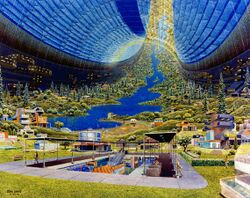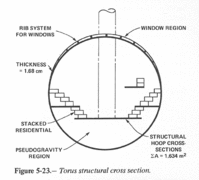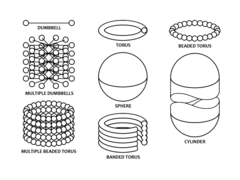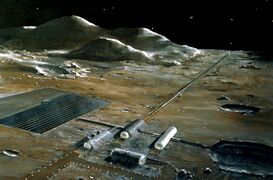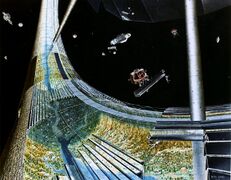Astronomy:Stanford torus
The Stanford torus is a proposed NASA design[1] for a space habitat capable of housing 10,000 to 140,000 permanent residents.[2]
The Stanford torus was proposed during the 1975 NASA Summer Study, conducted at Stanford University, with the purpose of exploring and speculating on designs for future space colonies[3] (Gerard O'Neill later proposed his Island One or Bernal sphere as an alternative to the torus[4]). "Stanford torus" refers only to this particular version of the design, as the concept of a ring-shaped rotating space station was previously proposed by Konstantin Tsiolkovsky ("Bublik-City", 1903),[5] Herman Potočnik (1923)Cite error: Closing </ref> missing for <ref> tag
Sunlight is provided to the interior of the torus by a system of mirrors, including a large non-rotating primary solar mirror.
The ring is connected to a hub via a number of "spokes", which serve as conduits for people and materials travelling to and from the hub. Since the hub is at the rotational axis of the station, it experiences the least artificial gravity and is the easiest location for spacecraft to dock. Zero-gravity industry is performed in a non-rotating module attached to the hub's axis.[6]
The interior space of the torus itself is used as living space, and is large enough that a "natural" environment can be simulated; the torus appears similar to a long, narrow, straight glacial valley whose ends curve upward and eventually meet overhead to form a complete circle. The population density is similar to a dense suburb, with part of the ring dedicated to agriculture and part to housing.[6]
Construction
The torus would require nearly 10 million tons of mass. Construction would use materials extracted from the Moon and sent to space using a mass accelerator. A mass catcher at L2 would collect the materials, transporting them to L5 where they could be processed in an industrial facility to construct the torus. Only materials that could not be obtained from the Moon would have to be imported from Earth. Asteroid mining is an alternative source of materials.[7]
General characteristics
- Location: Earth–Moon L5 Lagrangian point
- Total mass: 10 million tons (including radiation shield (95%), habitat, and atmosphere)
- Diameter: 1,790 m (1.11 mi)
- Circumference: 5,623.45 m (3.49 mi)
- Habitation tube diameter: 130 m (430 ft)
- Spokes: 6 spokes of 15 m (49 ft) diameter
- Rotation: 1 revolution per minute
- Radiation shield: 1.7 meters (5.6 feet) thick raw lunar soil
Gallery
A torus expanding from interconnected bolas or dumbbells
A NASA lunar base concept with a mass driver (the long structure that extends toward the horizon)
See also
- Asteroid mining
- Bernal sphere
- Colonization of the Moon
- Rotating wheel space station
- O'Neill cylinder
- Bishop ring
- Space colonization
- In fiction
- Aurora (novel)
- Gaea trilogy
- Ringworld
- Interstellar (film)
- Elysium (film)
- Citizen Sleeper (videogame)
References
- ↑ Johnson, Richard D.; Holbrow, Charles (1977). "Space Settlements: A Design Study". National Aeronautics and Space Administration. http://settlement.arc.nasa.gov/75SummerStudy/Table_of_Contents1.html.
- ↑ Johnson & Holbrow 1977, p. 1, "The Overall System", p. 60, Summary
- ↑ Johnson & Holbrow 1977, pg VII, "Preface"
- ↑ O'Neill, Gerard K. (1977). The High Frontier: Human Colonies in Space. Bantam Books. p. 149.
- ↑ Bekey, Ivan; Herman, Daniel (January 1, 1985). "Space Station and Space Platform Concepts: A Historical Review" (in en). Space Stations and Space Platforms-Concepts, Design, Infrastructure, and Uses. American Institute of Aeronautics and Astronautics. pp. 203–263. doi:10.2514/5.9781600865749.0203.0263. ISBN 978-0-930403-01-0. https://arc.aiaa.org/doi/10.2514/5.9781600865749.0203.0263.
- ↑ 6.0 6.1 Johnson & Holbrow 1977, Chap. 5
- ↑ Johnson & Holbrow 1977, p. 201
External links
 |

